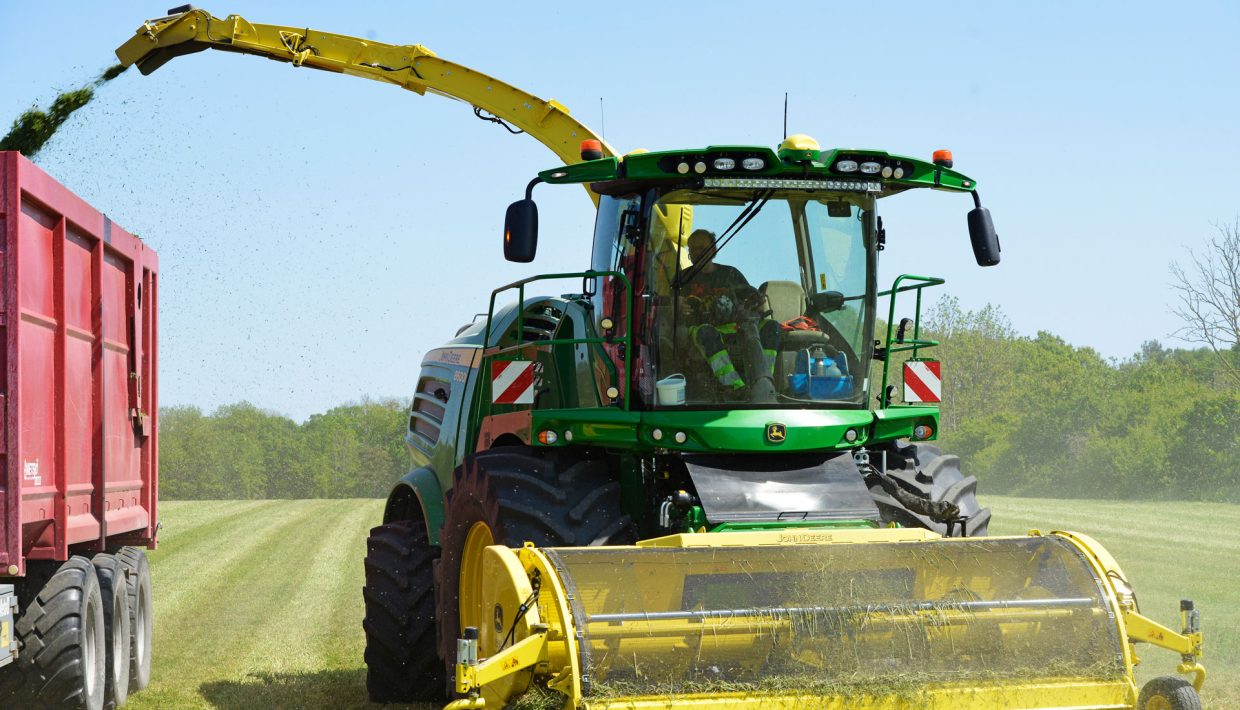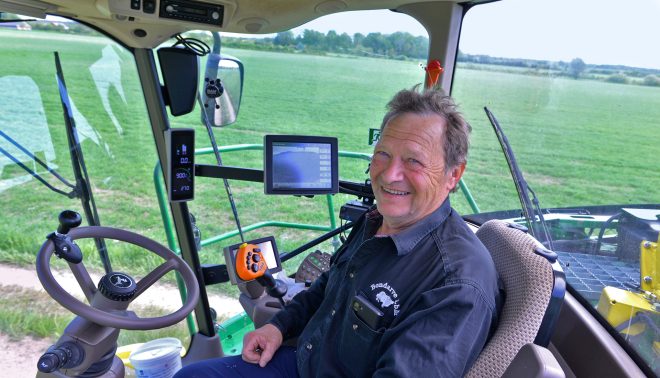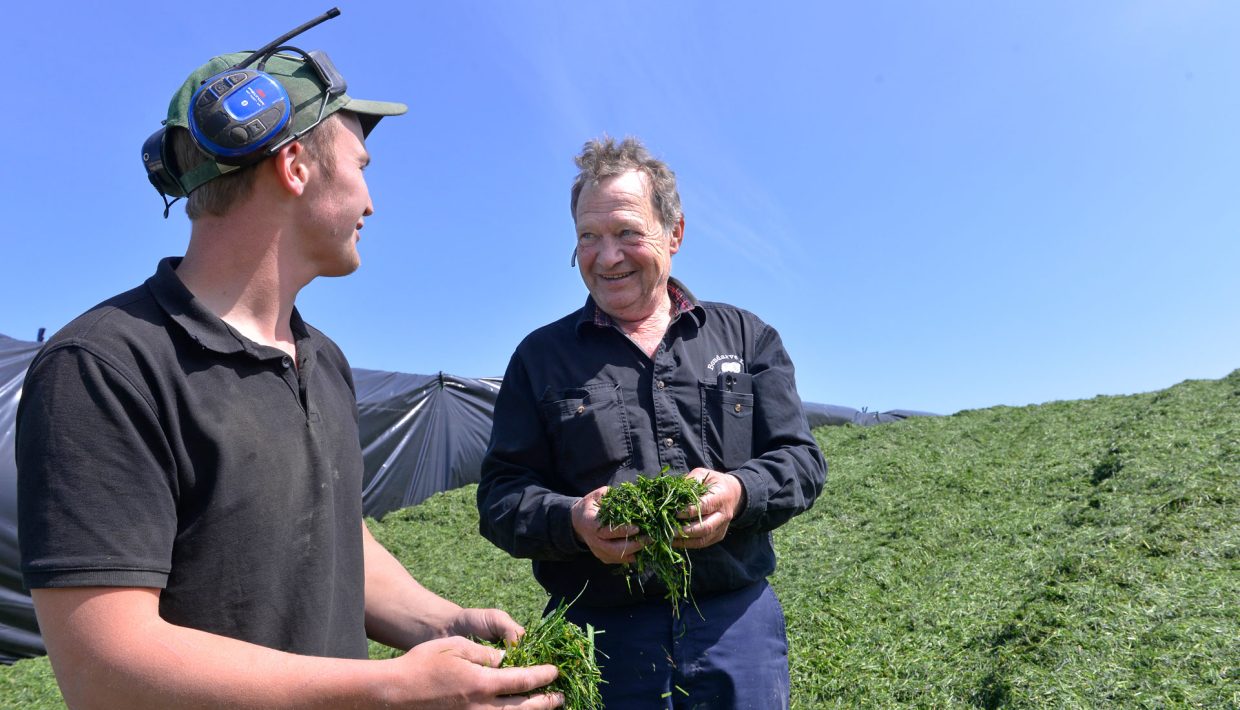Mr Nilsson, who farms at Levide Bondarve in the South of the Baltic Island of Gotland has 6ha to feed his herd of 130 steers, and on top, contract forages 3,000ha of grass and 700ha of maize silage for customers. Mr Nilsson says John Deere machines stood out from the competition when the brand first arrived on the island in 1974. “Their overall performance was better, and John Deere was determined to develop its machines to make them even better. I particularly liked the power output, as well as the transmission and cab comfort of the tractor,” says Mr Nilsson.
In early June, the first cut of grass took almost 16 hours a day for about a week. He had just received delivery of his latest purchase, a 2023 version of the 8600i forage harvester he ordered last year, making it his sixth forage harvester from the company. Alongside this machine, he runs another 8600i forage harvester that he bought in 2021.
Machine performance and efficiency increase
Mr Nilsson bought his first John Deere forage harvester in 1998. The machine’s performance and efficiency have improved over time. Fuel consumption has gone down, but the reduction has been partly offset by the required biofuel mix, so Mr Nilsson cannot put a figure on the savings.

However, the improved capacity and fuel efficiency has been an economic boost in times of high fuel prices. “Seven or eight years ago, we felt we could only run our harvesters for 300ha at most. Today we have no problem running it at 400ha,” he says, adding that in the field they can work at a rate of 4ha an hour per machine.
With almost 50 years of farming experience, Benny Nilsson has seen many changes in farming and machine technology. The introduction of computer software and programming in machines has meant a quantum leap in farming efficiency and productivity. However, users have also needed to upgrade their own skills.
The overall performance has improved over and over again.
Benny Nilsson
“I found it very difficult at first because we were not used to it, but it has gotten much better,” says Mr Nilsson Monitors in the cab are easy to use, with quick icon references. Before the touch screens, we had to punch in codes for different jobs. You almost needed a book to find the right codes.”
Mr Nilsson’s customers have also changed. Farms have become bigger and fewer, and he now has about 15 customers for grass and 40 for maize harvesting. However, the total area he manages has increased over the years, with maize area doubling in the last 10 years.

The John Deere dealer
But as the actual purchase of a machine is only the beginning of what can be a long relationship between the farmer and John Deere dealer, Mr Nilsson relies on immediate access to service and spare parts when they are needed. He is very satisfied with the service provided by his local dealer, Green Deere in Stenkyrka, Gotland.
“We have a great working relationship and I feel very safe with them. I can call them day or night, weekdays or weekends, and there is always someone there. They have been out in the evenings and late at night, and when I need a spare part, I always get it the next day,” says Mr Nilsson.
At the Green Deere dealership, site manager Berth Hansson and sales manager Rasmus Myrvälder tell us they currently have seven service technicians on call 24/7, ready to be with a customer and solve their problem within an hour or so. “When we sell a new forage harvester or any other machine, we give what’s called a ‘harvest promise’. This means that if we can’t deliver a spare part within 24 hours, we will send a replacement machine,” says Rasmus Myrvälder.

We want our customers to feel they are in good hands.
Berth Hansson
Green Deere has the support of John Deere, and even if spare parts must be delivered from stock in Germany, they usually arrive the next day. “We want our customers to feel that they are in good hands when something happens,” says Berth Hansson, who also has many years of experience in the industry.
In 1966, he started a workshop on the site where Green Deere now has its facility, and in 1974 the company became a John Deere dealer. They were part of the major re-organisation of the John Deere dealer network in the early 2010s that created the Swedish umbrella organisation for John Deere dealers. “As an old owner of the company, I’m very happy with the way things have turned out. It has given us a boost and we now have a solid business with a turnover of SEK 110 million in 2022,” he says.

Today, the Stenkyrka Deere dealership has all the machines and tools that Gotland’s farmers need and is also trying to expand its golf course machinery business. “When we start selling a new model, we have to train our technicians, sometimes even sending them to Germany, and we also have to make sure we have the special tools and spare parts,” says Rasmus Myrvälder.
All this gives the Green Deere dealer the base and strength it needs to reassure customers that technicians will be there when they need them. And the need for timely service and parts availability seems to have become more important over the years, according to Benny Nilsson. “The harvest window for the first cut of grass, which is the most important for dairy farmers who need high quality silage, is getting smaller and smaller. Today it’s just a week, but 15 years ago it was at least 14 days.”

What really matters is the quality of our grass.
Olof Molinder
A long-term client of Mr Nilsson at the Duckarve dairy farm, agrees. They harvest some 70ha per day of grass, with transport vehicles shuttling back and forth from field to farm, packing the grass for storage in bunker silos. “It´s been too dry, no rain for quite some time and the yield is only around 85% of normal,” says Olof Molinder, who together with his brother Filip and father Thomas run the 210 head dairy farm of mostly Holstein cows.
There is no room for error or delay
“The capacity and reliability that Mr Nilsson can offer with his services is what’s most important to us,” says Olof Molinder. The farm relies on Mr Nilsson’s services for the first grass cut of 170ha, which is the most important for them as dairy farmers, as well as for sowing and harvesting 40ha of maize. “When we cut the grass ourselves, we managed to harvest 40ha. Now, with Mr Nilsson’s help, we can do about 80ha a day. We usually do the second and third cuts, which are smaller and mainly for the young cattle, ourselves.
Mr Nilsson also provides the yield and dry matter content of the grass silage delivered by the HarvestLab tool and provides a full feed analysis of the maize silage as well. As Olof and his brother Filip gradually take over the farm, they plan to expand their business. By the end of the year, they plan to have 300 head of cattle, including dry cows. Just as importantly, they plan to increase the milk yield from an already high 11,700 kilos per cow to at least 12,000 kilos.

“We have installed milking robots and that helps. But what really matters is the quality of our grass feed, so we must time the harvest extremely well,” says Olof. This is the end of a huge and complex chain of production and services, sometimes lasting several years, which goes beyond Stenkyrka Green Deere dealer, and the Molinder family’s Duckarve farm.
From a wider perspective, their smooth co-operation is also of vital interest to the whole of Gotland, which promotes locally produced food, helping to attract around one million visitors to the island each year, generating a regional income of SEK 2.3 billion.
And finally, when it comes to managing their business relationship, Olof Molinder says it all boils down to a single phone call, that embodies all the necessary trust and reliability between the entire chain of stakeholders. “We call Benny, and he answers!”
